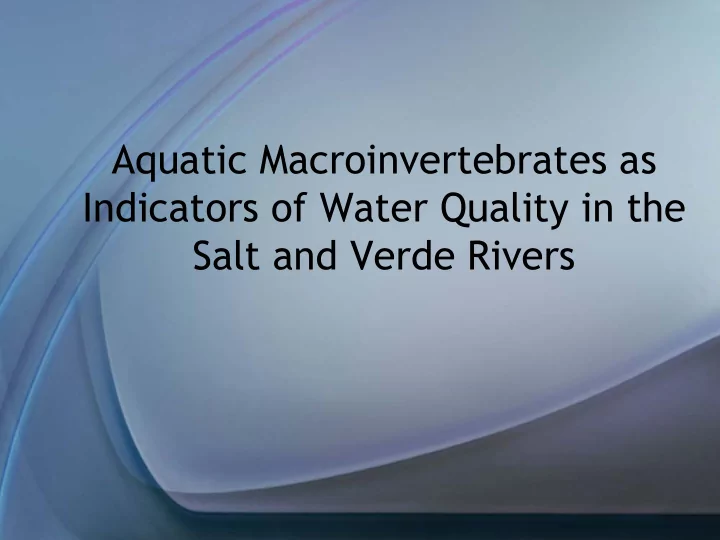

Aquatic Macroinvertebrates as Indicators of Water Quality in the Salt and Verde Rivers
Biocriteria and Bioassessment • Bioassessments provide integrated evaluations of water quality. • They can identify impairments of aquatic life from contamination of the water column and sediments from known or unregulated chemicals, non-chemical impacts, and altered physical habitat.
• Resident biota can function as continual monitors of biological integrity, increasing the likelihood of detecting the effects of episodic events, toxic non-point source pollution, cumulative pollution, or other impacts that chemical monitoring alone is unlikely to detect.
• Biocriteria can be used to assess to what extent current regulations are protecting designated and/or existing aquatic life uses.
Multimetric Indices to Prepare and Analyze Biological Data • Multimetric indices combine indicators, or metrics, into a single index value. • Each metric is tested and calibrated to a scale and transformed into a unitless score prior to being aggregated into a multimetric index. • Both the index, and the scale, are useful in diagnosing ecological condition.
Indices of Biotic Integrity • Calculated for Arizona’s perennial, wadeable streams (Patti Spindler, ADEQ). • Clustered into cold and warm water designations instead of ecoregions.
Warmwater metrics for Arizona as derived from reference streams. Metric Metric Threshold Value Total taxa 34 Trichoptera taxa 8.0 Ephemeroptera taxa 7.0 Diptera taxa 9.0 Scraper taxa 7.0 % Scraper 25.1 % Ephemeroptera 70.8 % Dominant taxa 20.9 Hilsenhoff Biotic Index 4.9
Index of Biotic Integrity assessment scores (warmwater) Exceptional Good Fair/Impaired Poor/Very Impaired 73-100 53-72` 27-52 0-26
Site Scores • Salt1 (Salta bove Roosevelt): 60 “good” • Salt2 (Salt below Stewart Mtn. Dam): 22 “very impaired” • Salt3 (Salt at Phon D. Sutton): 29 “impaired” • V1 (Verde at Sheep Bridge): 88 “exceptional” • V2 (Verde below Horseshoe): 41 “fair – impaired” • V3 (Verde below Bartlett Dam): 25 “poor – very impaired” • V4 (Verde at Beeline Hwy.): 34 “fair – impaired”
Reservoir Effect on Stream Biota 80 70 60 Mean(IBI Score) 50 40 30 20 10 0 Above Below
Why? • Regulated flows below the reservoirs lack of the right type and amount of disturbance needed for diversity.
Intermediate Disturbance Hypothesis • Suggests that the greatest biodiversity is maintained by disturbances of intermediate severity or frequency. • Very mild or rare disturbances allow competitive exclusion and produce low species diversity. • Very frequent or catastrophic disturbances cause local mass extinction and again, produce low species diversity.
• Intermediate disturbance, as is typically seen in unregulated streams/rivers, neither cause extinction or allow competitive exclusion. • They do prevent dominant competitors from increasing to shutout levels. • Thus, intermediate disturbances tend to maintain species diversity.
Oneway Analysis of Tolerance By Site 11 9 7 Tolerance 5 3 1 -1 SALT1 SALT2 SALT3 V1 V2 V3 V4 Site Oneway Anova Analysis of Variance Source DF Sum of Squares Mean Square F Ratio Prob > F Site 6 43.76029 7.29338 2.9548 0.0079 Error 364 898.46074 2.46830 C. Total 370 942.22102 Means for Oneway Anova Level Number Mean Std Error Lower 95% Upper 95% SALT1 74 6.50000 0.18263 6.1408 6.8592 SALT2 69 6.97101 0.18914 6.5991 7.3430 SALT3 53 7.09434 0.21580 6.6700 7.5187 V1 42 5.95238 0.24242 5.4757 6.4291 V2 35 6.42857 0.26556 5.9063 6.9508 V3 46 6.60870 0.23164 6.1532 7.0642 V4 52 6.86538 0.21787 6.4369 7.2938 Std Error uses a pooled estimate of error variance
Distributions Invert Family cyclorrhaphous brachycera Veliidae Tubificidae Tricorythidae Tipulidae Temoridae Tanyderidae Talitridae Tabanidae Sysiridae Stratiomyidae Sphaeridae Sperchontidae Simuliidae Pyralidae Psychodidae Planorbidae Planariidae Physidae Philopotamidae Odontoceridae Nemouridae Naucoridae Macroveliidae Lymnaeidae Lumbriculidae Limnocharidae Limnaeidae Libertiidae Libellulidae Leptophlebiidae Leptoceridae Hypogastruridae Hydroscaphidae Hydroptilidae Hydropsychidae Hydrophilidae Hydrodromidae Hydrobiidae Hydridae Hydrachnidae Helicopsychidae Haliplidae Gomphidae Glossosomatidae Gerridae Eylaidae Erpobdellidae Eremaeidae Empididae Elmidae Dytiscidae Dryopidae Dorylaimidae Dolichopodidae Daphniidae Cypridopsidae Cypridae Curculionidae Corydalidae Corixidae Corbiculidae Coenagrionidae Chironomidae Ceratopogonidae Centropagidae Carabidae Capniidae Candoniidae Calopterygidae Belostomatidae Baetidae Astacidae Ancylidae ------ 20 40 60
Questions?
Recommend
More recommend